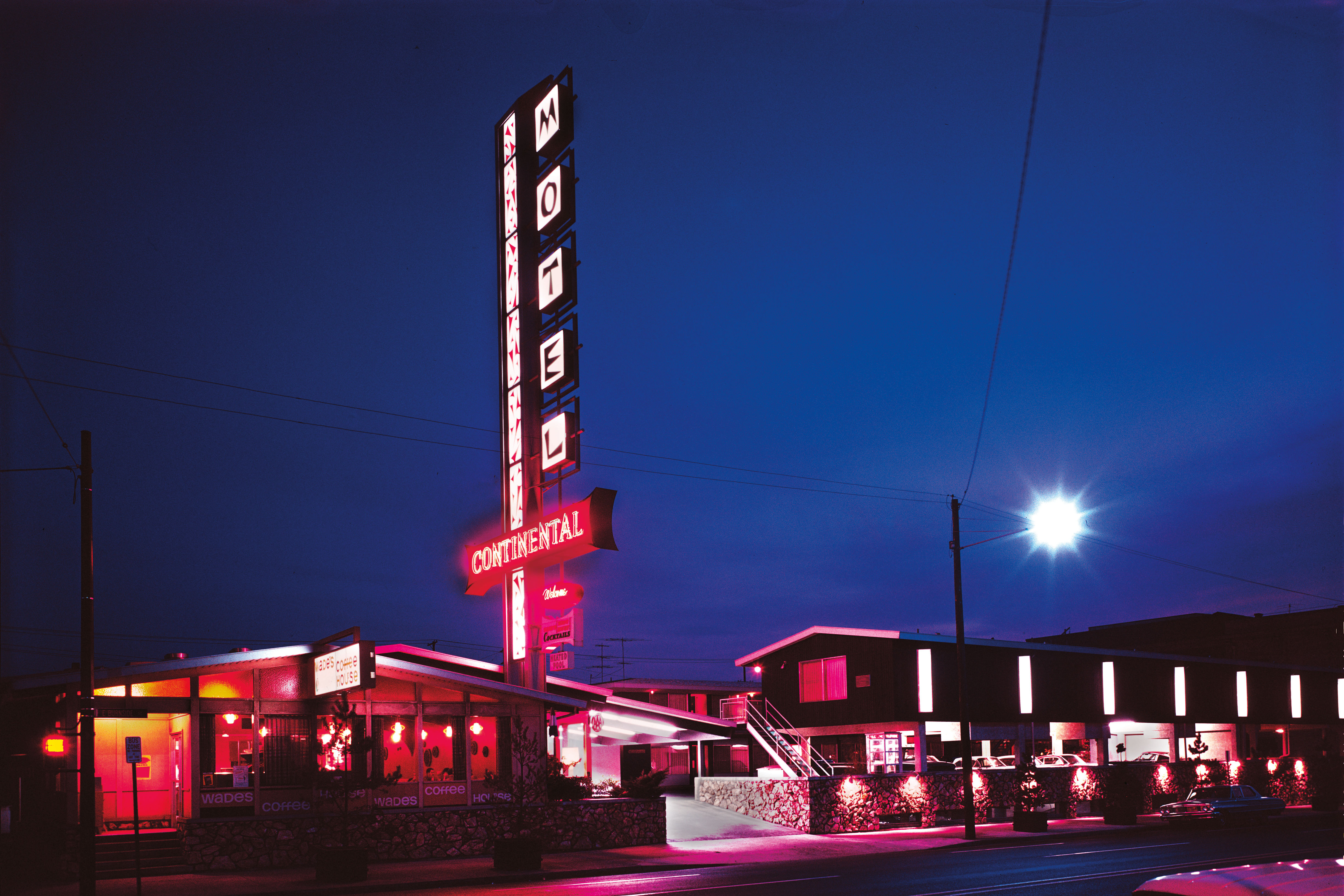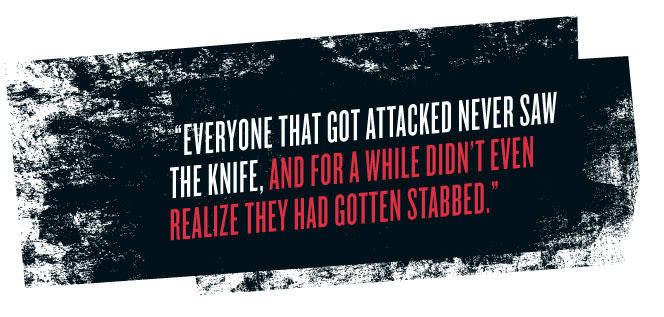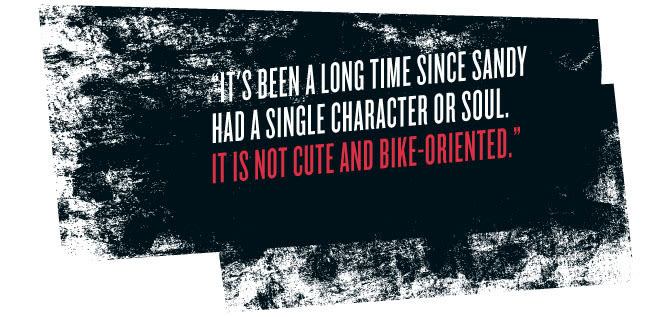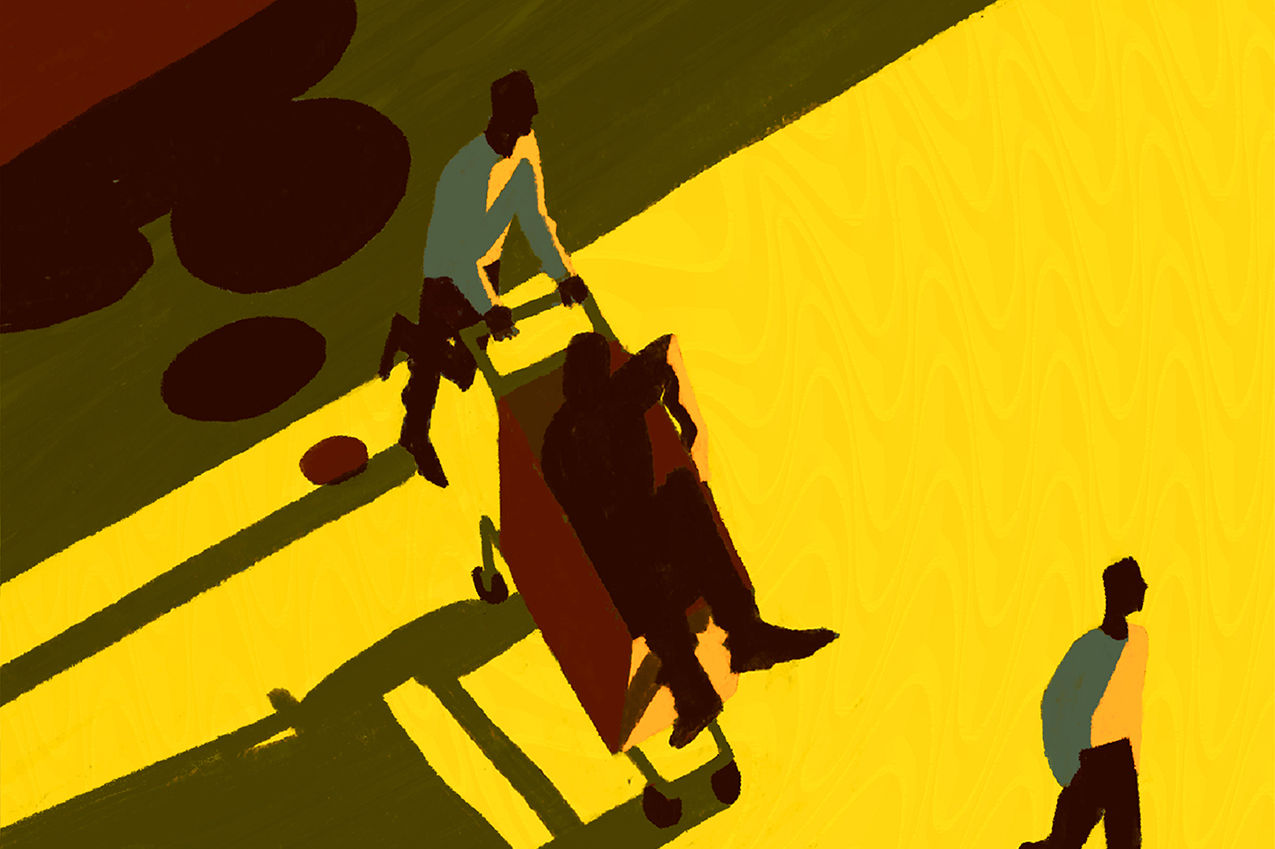
Sandy. Burnside. Two Streets at the Heart of Portland’s East Side—and Three Grisly Murders That Reveal Their History

The Continental
I
n June 1987, the Continental Motel hadn’t seen a tourist in a long time. The midcentury motor lodge had been built at the corner of East Burnside and Eighth Avenue in 1962, part of a hotel boom across Portland at the time. It had a swimming pool, restaurant (“With Atmosphere!”), and coffee shop. Even as the paint was drying, though, car prowls and burglaries stained its image. The few blocks of East Burnside connected that street’s namesake bridge to Sandy Boulevard, the diagonal that slashes traffic across Northeast Portland. The linked streets’ heavy flow of cars and succession of low-slung commercial lots fostered certain side effects: prostitution, drug dealing, and other crime.
By ’87, a rotating cast of junkies, ex-cons, prostitutes, and dislocated families passed through the Continental’s 80 or so rooms, scraping together $19.95 for a night or $99 for a week. Syringes littered the property. Housekeeping staff wore rubber gloves. The motel’s desperate manager called the neighborhood—within sight of the corporate towers just over the river—“one of the sleaziest areas in town.”
On a drizzly June day, a 26-year-old single mother named Candice Patricia Marie Straub checked into Room 214 with two 20-something migrant workers, Marco Montez and Timothy Aikens, whom she had met on a shift at a cannery the day before. The trio grabbed a meal and napped. Then, that night, the two men raped and murdered Straub. They wiped their fingerprints, disconnected the fire alarm, and set the room ablaze before hopping a freight train bound for Idaho. Both were captured and convicted; Montez, sentenced to death.
It was the definition of a senseless crime. But Straub’s horrific killing was also part of an era of violence, in Portland at large and at the Continental in particular. Two other murders had occurred at the motel since 1981, and two more would happen there before the decade’s end. The county reeled from over 100 homicides in 1987—more than double the previous year. (Portland recorded 34 homicides in 2015.) Crime plagued Sandy and Burnside.
“It’s just dopers and hookers and people that don’t have anywhere else to live,” one female Continental resident told the Oregonian, after the Straub killing. “I can’t even sit out on the stoop without some guy ... telling me to come over to him.”
Today, the short dogleg of East Burnside and Sandy’s long expanse—together, a key nexus of the city’s east side—are part of Portland’s revitalization (or gentrification, if you prefer). With three new luxury high-rises, lower Burnside is poised to become a sought-after real estate market, complete with an obnoxious nickname, “LoBu.” The syringes and despair of the Continental Motel are gone, washed away in the property’s 2004 rebirth as the Jupiter Hotel and Doug Fir Lounge, a swinging party lodge and bar offering weekend weed packages and sold-out indie-rock concerts. Sandy has sprouted a collection of cannabis dispensaries, earning the affectionate/derisive nickname the Green Mile. Microrestaurants and indie fashion boutiques lure pedestrians. The Hollywood District, clustered around Northeast Sandy, now boasts yoga and bike shops, smoked ribs and Whole Foods. At Sandy and 50th, the 53-year-old Der Rheinlander restaurant will soon become a brand-new health clinic.
But gloss can’t completely coat the streets’ deep history. Even as the city looks and feels like it’s being rebuilt before our eyes, an older Portland abides just below the surface. And in the case of a corridor once imagined as a spoke in a wheel of Parisian-style boulevards—since reshaped by technological and social change, failed utopian planning, neglect, and real-world urban expedience—three horrific crimes help peel back history’s layers.

The Corridor
A
road roughly like modern Sandy Boulevard appears on an 1852 survey map, made a year after Portland incorporated on the other side of the Willamette. (East Portland wouldn’t be annexed for four decades.) Before European settlement, a Native American trail traced the basic Sandy route, connecting the Willamette with large and small Chinook villages along the Columbia, including near the present-day locations of Portland International Airport and the Grotto. Later, white settlers used the same route, through farmland and creeks and springs, down toward the marshy area that is now the Central Eastside Industrial District.
Beginning in the 1870s, the rigid city grid began to creep eastward, but Sandy survived. By the end of the 19th century, today’s familiar street plan extended to NE 15th Avenue. By 1912, Sandy Boulevard had a streetcar line, servicing the “suburbs” around what is now Hollywood. Traffic counts from 1918 show cars flowing heavily over the old Burnside Bridge, which was replaced by its current version in 1926 to feed into Sandy.
At times, a desire to elevate Sandy into a citywide model took hold. In 1912, Edward Bennett—an English-born urbanist and coauthor of the landmark 1909 Chicago plan—proposed an ambitious vision, inspired by European metropolises and expressed in an ornate, grandiose style. Bennett’s Portland would be a web of stately, diagonal boulevards, radiating through Northeast and Southeast. Sandy would remain, the proud model for the rest.
“These days of slumberous patriotism need something tangible to stimulate the citizens’ pride,” wrote Bennett of his plan. “Architectural harmony and grandeur for ages have been the expression of the national soul.”
Obviously, the plan never happened. The real estate and population boom that began in 1905 with the Lewis and Clark Centennial Exposition petered out just as Bennett’s ink dried. Even as the balance of population shifted to the east side, the city ran short on money and political will to make good on Parisian dreams. Eventually, Burnside got wider, new bridges rose, and two-way streets became one-ways. But a grand new scheme for Portland’s traffic flow would not come until the 1940s, when legendary New York planner Robert Moses subordinated Sandy, and the rest of Portland’s traffic grid, to an almighty freeway loop.
Like an interior decorator’s front lawn, the Sandy-Burnside axis was allowed to go feral.
“It’s been a long time since Sandy had a single character or soul,” says historian Carl Abbott. “It is defined by the nodes that have grown up along it. It is not cute and bike-oriented like North Williams has become. But it is lots more useful in the ecology of the city.”
That ecology became a fertile habitat for cars. By 1930, one in four Multnomah County residents owned a car, above the national average. Sandy, a wide street with space for billboards and signage, was perfect for the new era. In 1949, Wallace Buick relocated its downtown dealership to 34th and Sandy. Within a decade, service stations, dealerships, and lodges lined the road, described by one city document as a “hybrid of a motel strip, shopping street, and semirural highway.”
The Continental Motel resulted from both the failed idealism of the Bennett plan and the hard reality that took hold instead. Yes, the specific horrors that unfolded in that cheap hotel room in June 1987 occurred because of random viciousness. But Straub’s murder also reflected the untamed cityscape outside. For a city renowned for its nearly religious devotion to planning, there was hardly anything intentional about Burnside and Sandy, except for discussion of untangling the six-point intersection where the two streets meet (final solution still TBD). Instead, a neglected, crime-ridden, accidental environment had grown up, a magnet for the isolated, the desperate, and the deranged. And as this critical stretch of Portland continued to evolve, violence would punctuate its changes.

The Driftwood
A
quiet Friday night, November 1994. The Driftwood Tavern, a diminutive dive at NE 67th and Sandy, was filled with the usual crowd. Andrew McDonald and Debra Oyamada, married for only about a year, whiled away the evening, drinking and playing video poker.
Mike Hefley, a retired lieutenant with the Portland Police Bureau, remembers that night vividly. This stretch of Sandy had a reputation for relative safety. “Each end of Sandy was pretty busy,” he explains, “busy” meaning plenty for cops to do. “As you head out to 82nd, you have a lot of small hotels and bars. The same on the other end, as you get down to 20th in the Burnside area: small motels with a lot of prostitution and drug sales. In between? A lot of nice neighborhoods. Not a lot going on.”
But around 10:30 p.m., two strangers entered the bar, Matthew Thompson and his friend Paul Whitcher. Thompson, later described as cold, manipulative, and unstable, with a fascination for knives and martial arts, accosted Oyamada at her video poker console, asking her if she had “Samurai blood.” Her husband, McDonald, intervened, and the bartender kicked out the newcomers. Thompson left with his friend. Minutes later, he burst back into the bar, wielding a four-and-a-half-inch boot knife, and lunged straight for McDonald.
Thompson stabbed three people: McDonald, Oyamada, and another customer who tried to help. The latter two survived, though gravely injured, but McDonald died at Emanuel Hospital later that night.
“Everyone that got attacked never saw the knife, and for a while didn’t even realize they had gotten stabbed,” recalls Hefley, adding that Thompson had probably practiced, based on the precision and speed of the attack. “Thompson inflicted over 40 knife wounds. He was like a sewing machine.”
Thompson fled the Driftwood on foot with Whitcher, but something soured their escape—maybe they disagreed about what to do next. Thompson killed his drinking buddy near the corner of NE 61st and Sacramento, nine blocks southwest of the tavern.
“It was a grotesque scene,” remembers Hefley, who was one of the first detectives to arrive at the corner. “It was early morning; there was steam rising off of the body.”
One theory that briefly arose in the investigation—Thompson was captured and, ultimately, convicted for the two murders and the assaults—concerned racial motivation. Oyamada was Japanese American. Thompson’s grandmother, with whom he lived in a house on NE 63rd, later told police she thought Thompson might be a skinhead. (At the time Portland was known as a hotbed of racist skinhead activity, including the 1988 murder of an Ethiopian student at Portland State named Mulugeta Seraw.)
In the end, the investigation did not reveal an ideological motive. But even an isolated attack on an interracial couple emblematized a complicated ethnic history—and a transformation which, before and after this crime, changed Sandy’s identity.

Little Saigon
A
s late as the 1940s, the area east of the Driftwood Tavern was a smattering of homes mixed in with large plots of farmland. In the words of one contemporary, “Above Sandy Boulevard that’s why there’s farms ’cause its sandy ground. Works real good.”
Japanese farmers owned many of those farms. In 1942, Executive Order 9066, authorizing Japanese “relocation,” put an end to that era. Today, the existence of that farming community has been all but been erased from the city’s collective memory, and few traces of Japanese agriculture remain in East Portland. (Meanwhile, in another change stemming from the World War II–era internment, Japantown is now Chinatown.)
In 1975, with the end of the Vietnam War, Sandy would change once more. Several refugee-aid organizations placed immigrants at a specific apartment building, a few blocks off of Sandy. At St. Rose Church at 57th, Father Minh Cao held masses in Vietnamese. As refugees trickled in during the ’80s and ’90s, that de facto shelter became a permanent home for many, and the church the heart of a thriving Catholic community.
“We had to have our own community to survive and to thrive,” says Thach Nguyen, cofounder of the Asian Pacific American Network of Oregon, who came to the United States in the initial wave of refugees in 1975. “A lot of people who don’t speak English well enough to work skilled jobs opened their own businesses. They pooled their resources. Two or three generations lived in the same household to save money. That’s how they survived.”
Survival had many challenges. Vietnamese gangs were implicated in murders and assaults on Sandy in the early to mid-1990s. According to Nguyen, the gangs grew out of a restless younger generation and a mutual distrust with the Portland police. (Police relations, and the gang problem in the area, are no longer significant issues, he notes.)
D’s Bar, the former Driftwood Tavern, now caters to dart throwers, trivia players, and Kansas City Chiefs fans. Today, there are about 29,000 Vietnamese in Oregon, with around 2,500 of them living around Sandy Boulevard. Vietnamese restaurants, beauty shops, travel agents, and grocery stores have thrived, visibly transforming the area into Little Saigon. Our Lady of La Vang Catholic Church on 54th and Sandy, with services in Vietnamese, now sits near the old St. Rose. Pho An Sandy and Yen Ha draw soup connoisseurs and barflies from around the city.
In retrospect, Thompson’s violence came just as this stretch of Sandy turned into something—again—unplanned. Old-time dives sit next to Vietnamese and other Asian restaurants, where elders still gather for lunch at back tables. There are new worries within the Vietnamese community that gentrification and anti-immigrant sentiment could erode the neighborhood. But somehow this part of an unremarkable, character-free traffic corridor became a distinctive urban Main Street. Crime has plummeted.

The Ambassador
O
n any given weekend in 1998, the Ambassador Lounge at NE 47th and Sandy, just a few blocks northeast of the theater that lends Hollywood its name, was popping. Along with the Galaxy (across from the Continental Motel), this place was one of only a few happening bars in town to offer karaoke, a hot trend that vexed local newspaper writers. (“No one is really sure why karaoke remains popular,” one reviewer wondered.) Partygoers and karaoke singers ate cheap Chinese noodles and knocked back Millers and screwdrivers while bartenders reached “arms over elbows” to serve drinks.
On Tuesday, February 24, 1998, the vibe was subdued, but still busy. Jacqueline Anderson, 29, was in the middle of a breakup with her boyfriend, Eric Running, 47, who had a history of heavy alcohol and drug abuse. Around 8 p.m., their argument escalated, and Running stormed out. Anderson soon called her close friend and sometimes lover, Barbara Gilpin, 44, who joined her for dinner and drinks. But around 11:15, Running returned, demanding that Anderson come outside.
“I’m going to kill you,” he told her, slicing a finger across his throat. Anderson shrugged. “I don’t like him very much anymore,” she told the bartender, as she carried drinks back to the pool area.
After retrieving a shotgun from somewhere outside, Running shot Gilpin as she was crossing the bar toward the entrance. Anderson remained calm and simply asked, “Are you going to kill me, too?”
Running shot her twice at point-blank range, and added one more round to Gilpin’s body.

Hollywood
I n the 1950s and ’60s, as dealerships and motels transformed lower Sandy and today’s “LoBu” into a soulless car-topia, Hollywood remained largely immune to that desolation, drawing life and energy as the town center for the neighborhoods of Laurelhurst, Grant Park, and Rose City Park and from a distinctive—distinctly attractive—architectural feel.
“Hollywood is the most obvious, and the theater the most prominent, boulevard landmarks,” says Abbott. “The neighborhood has continued to evolve and flourish in low-keyed ways.”
Indeed, the rise of the automobile was actually a boon to Hollywood. In the ’30s, the neighborhood saw the arrival of the first “suburban” Fred Meyer store (now a Rite Aid). In the 1930s, the address where the Ambassador is now was a Pay’n Takit, a grocery chain eventually acquired by Safeway. Yaw’s Top Notch at 41st and Sandy, where Franz Bakery is credited with inventing the world’s first modern hamburger bun, became the drive-in restaurant of the 1950s and ’60s.
With the 1926 Hollywood Theatre at its core—by the ’70s, one of Portland’s only old neighborhood cinemas not showing porn—the surrounding district emerged as a nightlife destination, with a number of upper-end establishments like Poor Richard’s (now closed), Sam’s Billiards, and nearby Prime Rib.
But the Ambassador murders highlighted a shadier side that emerged in the ’90s. Drug use and burglaries rose sharply in that era. Police shut down two motels after finding they were prostitution fronts and, in 1992, opened the area’s first neighborhood police station. The Ambassador had operated as R’s Hollywood Club until March 1990, when police raided a suspected gambling ring. (The owner later won $500,000 in damages from the city for the raid, and reopened the establishment as the Ambassador.)
But as is so often the case in older urban neighborhoods, this decline soon boomeranged into a countertrend: hipness. To paraphrase the iconic urbanist Jane Jacobs, the corridor’s old buildings attracted new ideas.

The Future
C
hanges have come to Sandy and Burnside quickly in recent years, and look to continue apace with the rest of the city. In utilitarian language that would make the grandiloquent Bennett weep on stylistic grounds, the 2035 Comprehensive Plan calls for mixed-use buildings, up to six stories, along with bike lanes and better pedestriancrossings on Sandy. Those changes might eventually give the area a calmer, more residential vibe.
In the meantime, the places where these crimes occurred are, for now, still with us. The former Continental is practically unrecognizable, but its dated architecture is now part of the retro appeal of the Jupiter, a hub of the indie commerce that has defined Portland in the ’00s and ’10s. Three of the murderers—Marco Montez, Matthew Thompson, and Eric Running—still sit on Oregon’s death row. (The state has declared a moratorium on executions.)
The city changes, sometimes because citizens and officials decide to change it, other times seemingly of its own organic will. Sandy is not our only street shaped by accident and circumstance, shadowed by dark history—nor will it be our last. We think we know what this part of the city is becoming: an on-brand Portland avenue, filled with walkable, Instagrammable, safe ways to spend time and money. But who can say how future generations will use the things we build today?
The author would like to thank historian JD Chandler for his research assistance in preparing this story.
Top Image: Courtesy Historic Photo Archive




